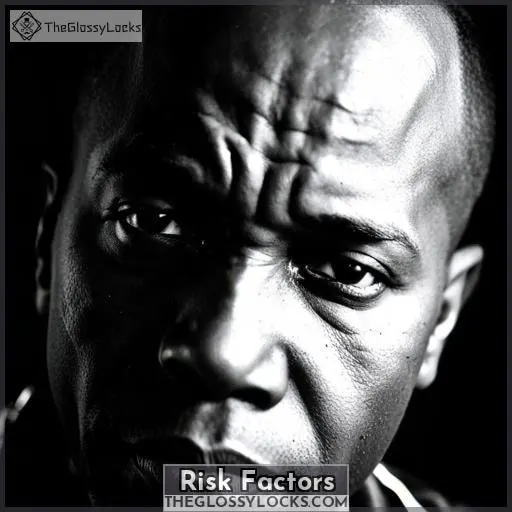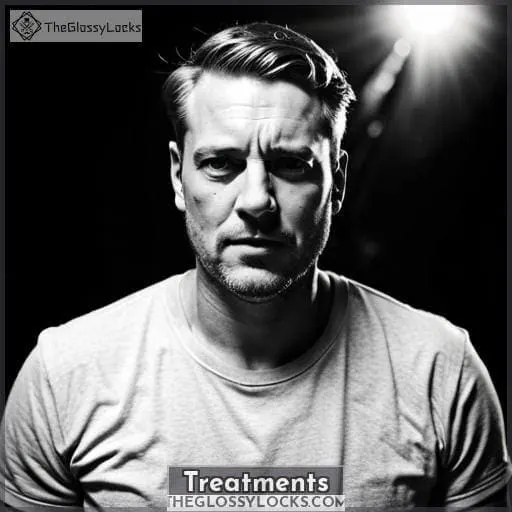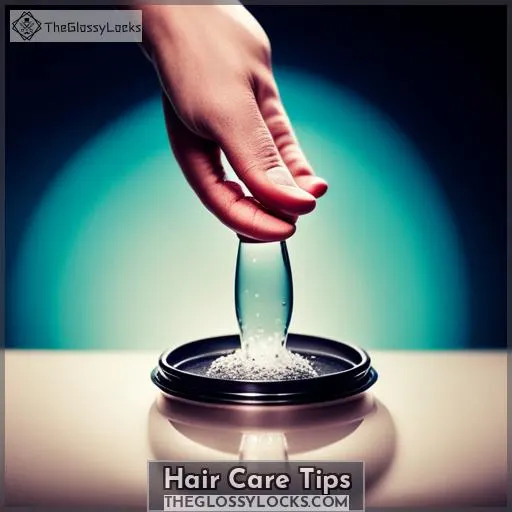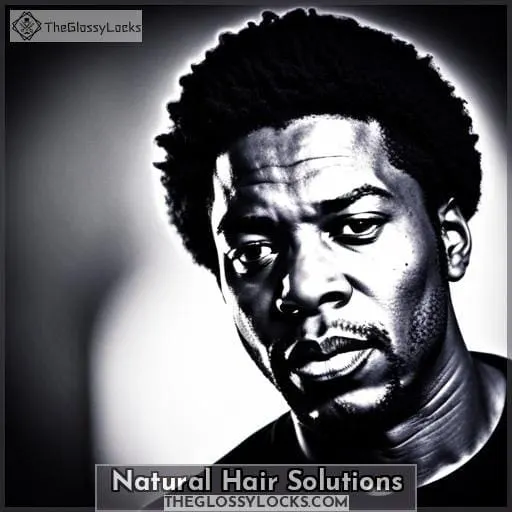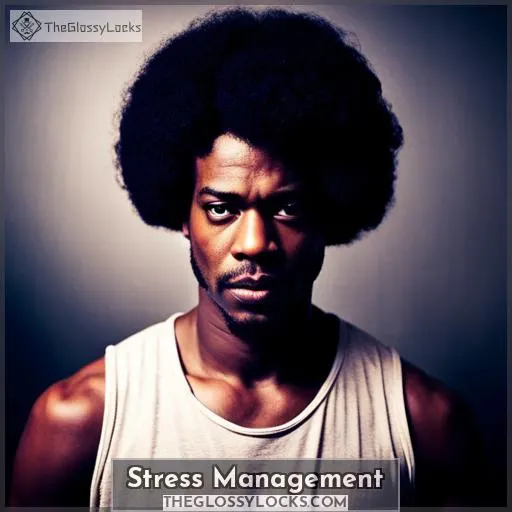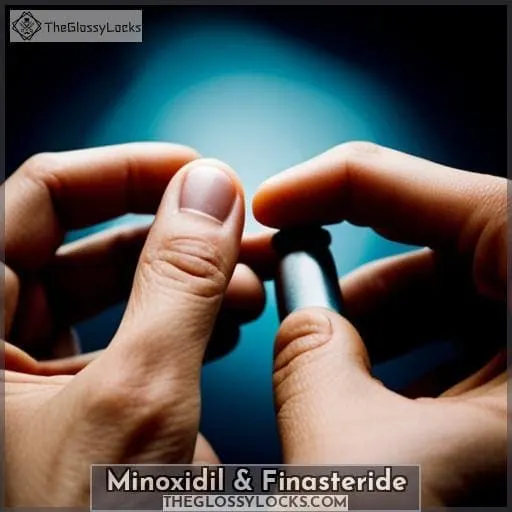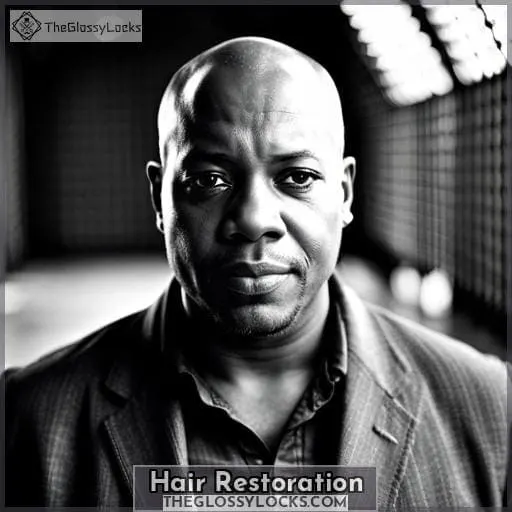This site is supported by our readers. We may earn a commission, at no cost to you, if you purchase through links.
Do you want to keep your hairline looking strong and healthy for years to come? Hair loss is a common problem among Black men, with an estimated 30-50% of them experiencing some degree of male pattern baldness by age 50.
If you’re concerned about losing your hair, it’s important that you understand the causes and risk factors associated with hair loss in Black men.
In this article, we share tips on how to prevent and treat hair loss in 2023 so that you can have a full head of healthy locks! From medications such as Minoxidil & Finasteride to natural solutions like scalp massages or stress management techniques – we cover all the bases.
So, no matter what stage your alopecia is at right now, there are ways for us as black men to fight back against our receding hairlines together.
Table Of Contents
Key Takeaways
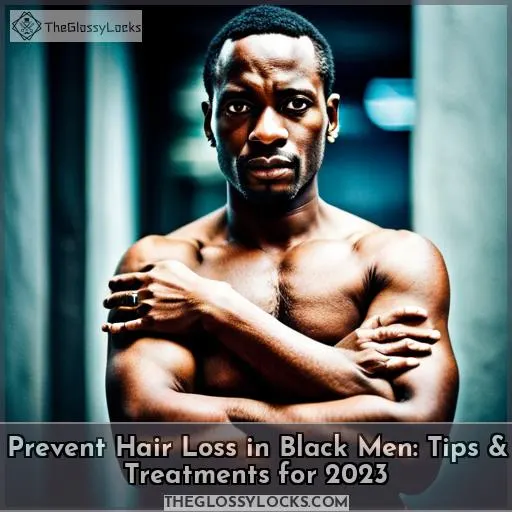
- Male androgenetic alopecia is the most common cause of hair loss in black men.
- Healthy styling practices and recovery conditioners help prevent traction alopecia.
- Treatments like minoxidil and finasteride can slow or halt hair thinning.
- Managing stress levels and maintaining a healthy lifestyle are essential for preventing hair loss in black men.
Causes of Hair Loss
It can be difficult to cope with a receding hairline, especially when it is caused by heredity. Male androgenetic alopecia – commonly known as male pattern baldness – is the most common cause of hair loss in Black men.
This type of alopecia is linked to hormone production levels, specifically testosterone. Too little testosterone can lead to an overproduction of DHT, which interferes with healthy follicle growth.
Androgenic Alopecia
Androgenic alopecia, which is often hereditary and due to changes in hormones, can cause a receding hairline in Black men. For example, Carl had been self-conscious of his receding hairline since he was 18 but didn’t realize it could be caused by androgenic alopecia until he consulted with a doctor.
To reduce DHT production associated with this condition, treatments like minoxidil may help slow or halt the progression of thinning hair. Additionally, healthy styling practices such as trimmed styles that do not pull on the scalp are beneficial for preventing traction alopecia.
Recovery conditioners designed specifically for black men’s needs aid healthier growth cycles.
Male pattern baldness is also treatable through options such as PRP therapy or stem cell therapies. These aim to stimulate new follicle development from harvested cells directly onto the scalp area affected by male androgenetic alopecia.
Testosterone
You may find that testosterone levels play a role in your receding hairline, as it can lead to the production of an enzyme known as dihydrotestosterone (DHT). DHT has a negative effect on hair growth by reducing blood supply to the follicles.
Hereditary factors are also involved, with male pattern baldness often passed down through generations. High levels of androgen hormones like testosterone can trigger androgenic alopecia, which leads to thinning or loss at the temples over time.
To reduce this effect, castor oil treatments have been found useful for restoring lost nutrients and promoting healthy new growth cycles.
Risk Factors
It is important to be aware of the risk factors associated with hair loss for Black men, such as genetics, radiation therapy, medications, alopecia areata, and stress. Having a better understanding of these potential causes can help you take steps towards preventing or minimizing hair loss in your own life.
By taking proactive measures like eating a healthy diet and avoiding styles that pull on the scalp’s hair follicles, you can reduce your chances of developing thinning or balding areas on your head.
Genetics
Hereditary factors can play a role in receding hairlines, with hair loss patterns often passed down through generations. Genetic makeup may influence DHT production, testosterone levels, and the pattern of hair loss.
A family history of male pattern baldness could be an indicator that you have a genetic predisposition to this type of alopecia. Hair follicles in men become sensitive to male hormones, which can lead to thinning or complete hair loss on the top and sides of the head if left untreated.
Radiation Therapy
Radiation therapy, such as chemotherapy or radiation for cancer treatment, can also cause hair loss in Black men. Radiation exposure and dose effects vary based on several factors that may lead to alopecia.
Taking healthy habits like avoiding heat styling and harsh chemical treatments is key to recovering from the damage caused by radiation therapy.
Eating a nutritious diet with vitamins and minerals, using scalp massage techniques along with topical hair oils, can help promote natural regrowth of lost locks due to radiation risks or androgenetic alopecia.
Low-level laser therapy, stem cell treatment, and PRP therapies are other options available for those seeking advanced methods of restoring their receding hairlines over time.
Medications
Medications like minoxidil and finasteride can help fight a receding hairline, offering an effective solution to thinning locks. These medications reduce the levels of hormones that lead to hair loss, which may be caused by genetic predisposition and DHT production.
In some cases, blood tests may be required for an accurate diagnosis. It is important to consider side effects, including sexual dysfunction, when taking medications for a receding hairline or other causes such as cancer treatment or cold laser therapy.
Regular use of these treatments can promote hair growth while avoiding further damage from harsh styling practices. This allows Black men to regain their desired look without compromising their health.
Alopecia Areata
Alopecia areata, an autoimmune disorder that causes patchy hair loss, can lead to a receding hairline in some Black men. DHT effects may be present due to genetic influence, and its prevalence is lower than in white men.
Treatment options include red light therapy or natural solutions like managing a healthy lifestyle and reducing stress. To counter the impact of DHT on blood flow, scalp micropigmentation or stem cell therapies can help restore lost follicles with long-lasting results.
Stress
Managing stress can be a daunting task, but it’s essential to conquer the battle of receding hairlines – like an unstoppable warrior taking on his enemies. Genetics and diet play key roles in reducing tension and supporting healthy hair growth.
Eating heart-healthy food, exercising regularly, incorporating oils into your regimen, and getting regular hair care will help combat stress-related hair loss.
Treatments
If you are experiencing hair loss as a Black man, it is important to be aware of the treatment options available. Medications such as minoxidil and finasteride can help prevent further hair loss, while more advanced treatments like hairline restoration (hair transplant), red light therapy, PRP therapy, stem cell therapies, and scalp micropigmentation offer more permanent solutions for restoring lost or thinning areas.
It is essential to research these treatments thoroughly before making any decisions about your care plan.
Medications
You have the power to take control of your hairline and restore it with medications like minoxidil and finasteride. These treatments can help prevent DHT production, reduce hereditary factors, and increase testosterone levels in black men.
However, they may also cause side effects, so be sure to speak with a doctor before using them. Certain medications or medical conditions can influence the degree of male pattern baldness too; understanding these risk factors is key for successful treatment outcomes.
Hairline Restoration
For those struggling with a receding hairline, hairline restoration offers long-lasting results. Surgical options, such as a hair transplant, can help restore lost locks and prevent further loss. Genetics research has also found that stem cells, coupled with natural oils, can reduce little to no loss in some cases.
To ensure optimal results, following key preventive measures like scalp care is essential for any medical procedure related to baldness or thinning hair.
Red Light Therapy
Exploring the potential of red light therapy can help you regain control over thinning locks and restore your hairline.
- Photobiomodulation to stimulate healthy hair growth in afro hair.
- Side effects are minimal when compared to regular treatments.
- Essential nutrients, physical activity, and regular scalp care promote positive treatment outcomes. Red light therapy helps maintain a strong foundation for long-lasting results with no scarring or downtime!
PRP Therapy
PRP therapy is an increasingly popular way to regrow hair with a 90% success rate. It utilizes protein-rich blood platelets to revitalize the scalp and promote healthy hair growth. Benefits include improved circulation, enhanced cell activity, and special attention for thinning locks.
Risks are minimal with proper care; cost varies based on individual needs; recovery time may be short or long depending on the treatment plan; results vary but tend to last if accompanied by a regular hair care routine.
Stem Cell Therapies
You can try stem cell therapies to help regrow hair on a receding hairline. Cell regeneration and an infusion of protein-rich platelets are key components in this therapy, which promotes healthy follicle cells for hair growth.
A daily 4-minute scalp massage can also aid restoration for lost hairs due to male pattern baldness in black males.
Scalp Micropigmentation
Scalp micropigmentation is a long-term solution for receding hairlines. Tiny dots are tattooed on the scalp to reduce the contrast between thinning hair and the head, offering natural-looking results. Benefits include healthier DHT levels, revived hair follicles, pigment patterns that mimic real hairs, and enhanced growth potential with proper care.
Hair Care Tips
If you’re a Black man wanting to prevent hair loss, there are some key steps you can take. Taking the time to condition your hair regularly with specialized products like Hair Recovery Conditioner for Men can help restore and preserve healthy locks.
Massaging your scalp daily promotes thicker tresses as well as new growth, while regular exercise provides essential vitamins and minerals directly to the scalp. Oils such as castor oil or pumpkin seed oil also benefit natural hair by boosting its appearance and strength.
Additionally, avoid washing it every day to keep natural oils intact, while heat styling should be avoided altogether due to potential damage that it may cause in this delicate area of the head.
Conditioner
Deep conditioning your hair is key to promoting healthy and rapid growth. Treat yourself to a recovery conditioner like Hair Recovery Conditioner for Men that can restore and preserve luscious locks.
Protein Treatment
Rejuvenate your locks with protein treatments to restore damaged hair and foster growth. DHT effects, hereditary factors, and scalp massage are key in treating the most severely damaged hair. Protein treatment strengthens follicles for rapid growth, while effective methods of care address health issues identified by the scientific community.
Massaging
Massaging your scalp regularly can help thicken hair and promote healthy new growth. Properly nourishing the follicles with sufficient quantities of natural oils and stimulating them with specific male hormones will aid in reversing the effects of receding hairlines.
Stress management, exercise, avoiding harsh styling practices, and managing any existing heart disease are also key components to preventing hair loss or baldness due to lack of proper nutrition.
Exercise
Regular exercise can turbocharge the scalp and send vital nutrients to your follicles, making them stronger than ever! Exercise benefits include additional weight loss, improved hours of sleep, and fewer stress hormones.
The best approach is a combination of intensity and frequency tailored to you. Eat plenty of greens plus well-known ingredients like biotin and saw palmetto for maximum effect.
Oils
Using natural oils to nourish the scalp and hair can help strengthen BIPOCs’ delicate cuticles from harsh treatments. Castor oil, pumpkin seed oil, and daily scalp massages are beneficial for deep conditioning; they promote healthy growth while reducing the most common cause of a receding hairline: male pattern baldness.
Identifying possible causes is key to finding the least helpful solutions similar in cause or significant loss due to heredity/hormones.
Avoid Washing
Avoiding daily hair washes can help keep natural oils intact and protect delicate cuticles from harsh treatments. Heat styling should be avoided to prevent damage. A nutrient-rich diet, stress management, and the use of beneficial oils are essential for long-term success in achieving perfect hair.
The recursive loop of haircare is a common reason BIPOCs struggle with maintaining their sulfur connections, resulting in short-term dryness and brittleness, ultimately leading to loss.
Avoid Heat Styling
Heat styling can compromise the integrity of your hair, so steer clear for luscious locks and a healthy mane. Moisturizing treatments, protective styling, and natural oils protect from heat damage while promoting growth.
Incorporate regular hair care practices to minimize breakage, maintain sulfur connections, and prevent loss in Black men.
Avoid Traction Alopecia
To maintain a healthy hairline, be mindful of certain hairstyles that could lead to traction alopecia. This type of hair loss is caused by repeatedly wearing tight braiding patterns and other styles that pull on the scalp.
In order to protect your locks from damage, opt for looser styles or choose protective styling methods such as buns or updos when possible. Hair maintenance should also include regular deep conditioning treatments with specialized products designed specifically for Black men’s hair types to repair strands weakened by harsh product ingredients and environmental factors like sun exposure.
Additionally, make conscious decisions about product choice. Oils rich in nutritional components can help keep natural tresses looking their best, while avoiding heat-based tools can prevent over-drying and breakage due to excessive use.
Finally, develop healthy habits like eating nutritious foods high in vitamins and minerals and getting enough sleep. These habits will promote faster growth while relieving stress levels, which often cause thinning issues at any age.
Natural Hair Solutions
Now that you’ve learned how to avoid traction alopecia, let’s discuss natural hair solutions.
To keep your receding hairline healthy and strong, try incorporating these tips into your routine:
- Deep condition regularly with a specialized product designed for Black men’s hair types.
- Use protein treatments to help restore damaged strands and promote growth.
- Avoid heat styling tools. Air drying is best for preventing damage caused by overuse of hot products like blow dryers or flat irons.
Additionally, nourish locks with natural oils such as castor oil or pumpkin seed oil – both are rich in essential nutrients beneficial to the scalp and follicles!
Lastly, limit washing frequency as it can strip away necessary oils needed for hydration and softness while promoting breakage along the fragile cuticle layer of Black men’s tresses.
With these helpful tips in mind, plus lifestyle changes such as maintaining a balanced diet full of vitamins and minerals, regular exercise, and daily massaging techniques on the scalp, you’ll be well on your way towards restoring volume back onto those thinning areas around the temples!
Healthy Diet
Maintaining a healthy diet full of vitamins and minerals is key to promoting strong hair growth, so make sure you get your daily recommended servings of fruits and vegetables! A diverse nutrient intake helps ensure that you’re receiving all the essential nutrients needed for healthy locks.
Eating foods rich in protein, such as lean meats, dairy products, nuts, and beans, can help maintain scalp health. Vitamin deficiencies may cause thinning or loss of hair. Including plenty of vitamin-rich sources like citrus fruits into your meals will help prevent this issue from occurring.
It’s important to remember that no single food group should dominate over others – adopt a balanced diet with variety instead! Remembering these tips can be hard sometimes, but making small changes each week towards healthier eating habits can go a long way when it comes to keeping those receding hairlines at bay!
Stress Management
Managing stress levels is essential for keeping a healthy head of hair, as it can have a direct impact on your scalp health. Practicing relaxation techniques such as yoga or deep breathing can help reduce the body’s cortisol levels and make you more resilient to stressful situations.
Mindful practices like journaling and meditation are also helpful in managing stress. It’s important to prioritize self-care activities that bring you joy – whatever they may be! Positive thinking plays an important role too; try centering yourself with affirmations or focusing on things that bring you peace when feeling overwhelmed.
Another great way to manage stress is by taking breaks from work, social media, etc.
Minoxidil & Finasteride
Treating your receding hairline with medications like minoxidil and finasteride is like putting a band-aid on a broken arm—it provides temporary relief, but won’t heal the underlying issue.
To help prevent baldness and promote natural hair growth:
- Block DHT hormones to reduce thinning of existing hairs.
- Balance hormone levels that affect scalp health for optimal growing conditions.
- Stimulate circulation in the scalp to supply nutrients necessary for new growth as well as follicle rejuvenation over time.
- Use products designed specifically to battle against male pattern baldness such as Hair Recovery Conditioner for Men or protein treatments that strengthen weakened strands due to regular treatments weakening sulfur connections in Black men’s hair.
- Monitor changes in diet, lifestyle habits, and stress levels regularly – all play an important role when it comes to preventing further loss of volume around your temples or crown while encouraging regrowth naturally!
Taking control of your own health can be empowering – you deserve thicker, healthier-looking locks without any harsh side effects!
Hair Restoration
If you’re looking for a more permanent solution to your receding hairline, hair restoration could be the answer. This replacement therapy is designed to restore thinning areas of the scalp and promote regrowth in those areas.
It involves removing healthy follicles from donor sites and grafting them onto bald or thinning spots on the head.
In addition to replacing damaged hairs, it’s important to practice proper scalp care. You should also nourish existing strands with natural alternatives like protein treatments or deep conditioning products.
While there are no guarantees that every person will experience satisfactory results from this procedure, many find that their confidence increases when they see visible signs of improvement.
Frequently Asked Questions (FAQs)
Is hair loss reversible?
Hair loss is often hereditary, affecting up to 50% of men by age Reversing it can be possible with medication and lifestyle changes. Minoxidil and finasteride address hormonal imbalances, while deep conditioning helps restore the strength of the hair.
Protein treatments, a healthy diet rich in vitamins and minerals, and regular scalp massage all promote new growth.
What are the long-term effects of hair loss?
Long-term effects of hair loss can include lowered self-esteem, depression, and stress. It is important to seek help from a doctor if hair loss persists for more than three months. Treatment options like medications and scalp micropigmentation are available to restore confidence and help individuals feel empowered.
Is there any way to prevent hair loss?
You can take steps to prevent hair loss by maintaining a healthy lifestyle, reducing stress levels, avoiding tight hairstyles, and harsh chemical treatments that pull at the scalp. Medications such as minoxidil and finasteride may help slow or stop hair thinning.
Are there any natural remedies for hair loss?
Yes! There are natural remedies for hair loss, such as deep conditioning treatments, protein therapies, and scalp massages. Eating a healthy diet rich in vitamins and minerals can also help promote new growth.
Using nourishing oils like castor oil or pumpkin seed oil may support thicker hair.
Is it possible to regrow hair on a receding hairline?
Yes, it is possible to regrow hair on a receding hairline. With the right medication and lifestyle changes, you can reduce thinning and promote new growth. Try deep conditioning treatments like protein-rich conditioners or powerful oils for healthy locks.
Conclusion
It’s important to take a holistic approach to preventing hair loss in Black men. While medication can be helpful in halting a receding hairline, a healthy lifestyle, regular exercise, and stress management can all help promote healthy hair growth.
To keep your hairline strong, avoid styles that pull on the hair and harsh chemicals, while opting for natural solutions like deep conditioning and protein treatments. To allude to the future, with the right steps, you can maintain a healthy hairline and be confident in your look.

